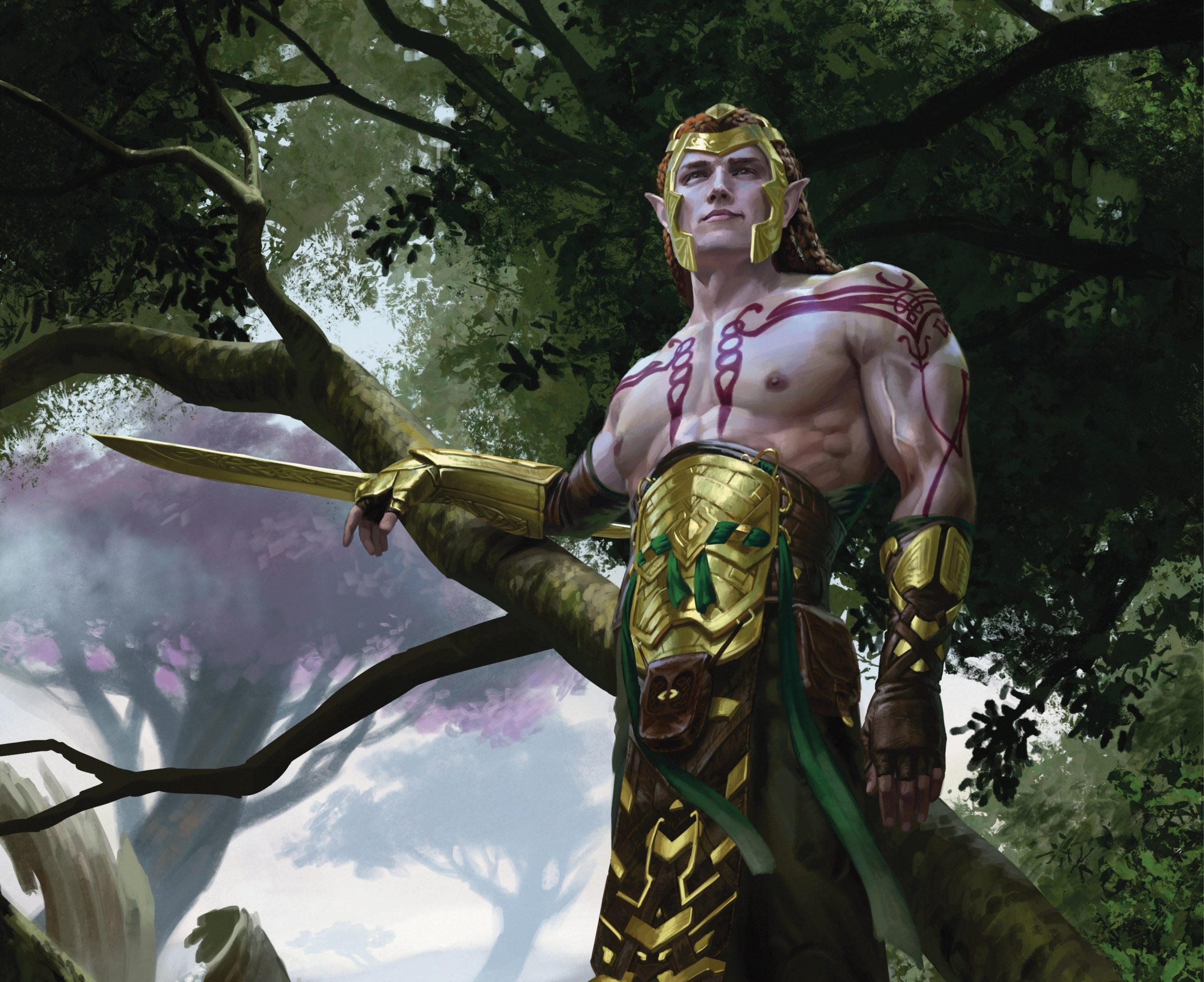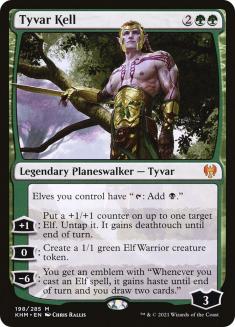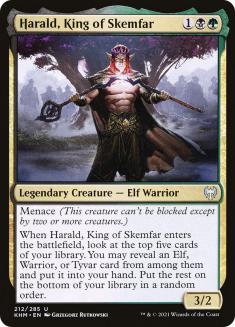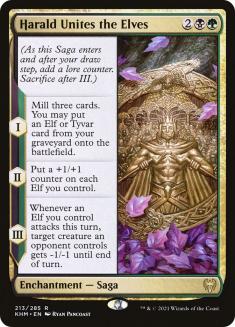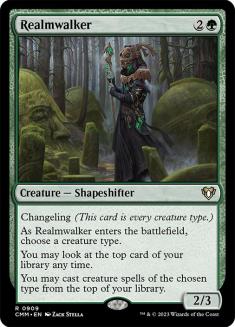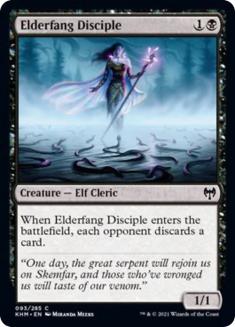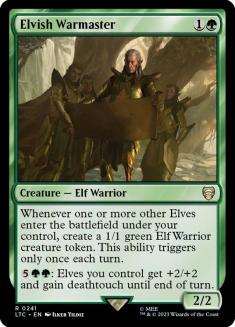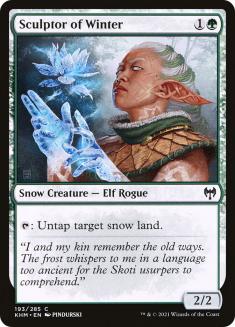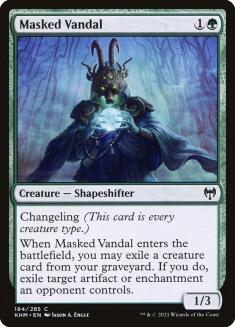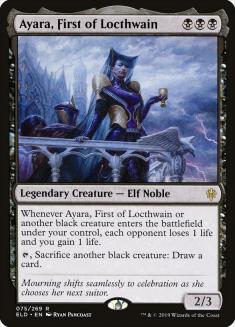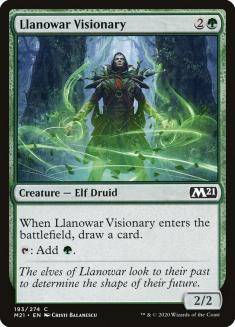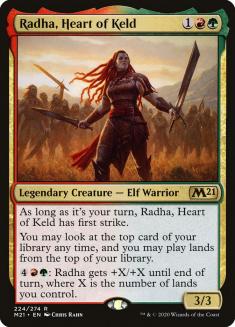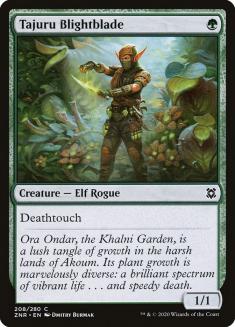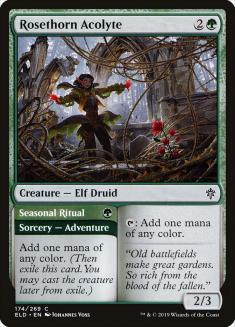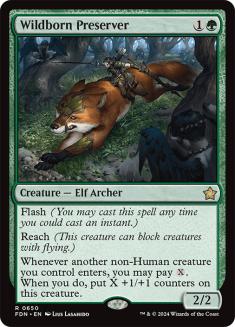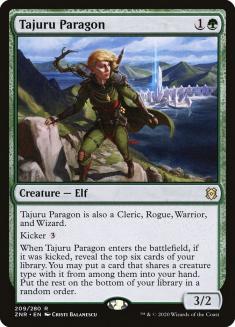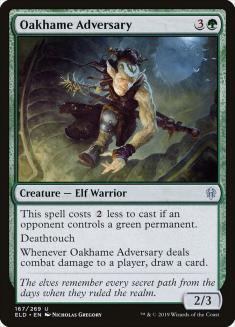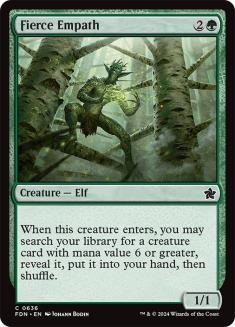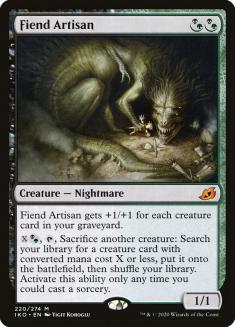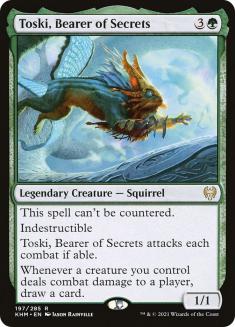If it weren’t for Shaheen Soorani, maybe I would have won the crown for unofficial champion of previewing planeswalkers this season. Alas, Niko Aris is an Azorius Control-slanted card, so it would have been hard to pry that one from Soorani’s hands.
Today we’re talking about Tyvar Kell. While in many ways Kaya the Inexorable and Tibalt, Cosmic Impostor represent flexibility, Tyvar Kell is aggressively telling you what to do. Play Elves.
At surface level, Tyvar’s most attractive feature is its passive ability.
Elves you control have “T: Add B.”
Make all of your Elves into mana creatures, and while you’re at it, you should probably be playing black since Golgari are the Elf colors in Kaldheim.
[0]: Create a 1/1 green Elf Warrior creature token.
Combined with Tyvar’s 0, Tyvar can spit out mana creatures the rest of the game, which scales quickly.
[+1]: Put a +1/+1 counter on up to one target Elf. Untap it. It gains deathtouch until end of turn.
Tyvar’s +1 is a bit less exciting, but it also basically reads as “generate a mana this turn with upside” similarly to how Nissa often functions, and it has the added benefit of enabling chip shots with the combination of deathtouch and a counter.
[-6]: You get an emblem with “Whenever you cast an Elf spell, it gains haste until end of turn and you draw two cards.”
Tyvar’s ultimate is slow and plodding, but if you do reach it, you’re an overwhelming favorite to win the game. Make a quick note that Tyvar’s ultimate is exactly twice the value of its starting loyalty (we’ll get back to that).
While examining Tyvar, I think we’d be remiss to not quickly highlight the cards that yell from the treetops to play in combination with the Elvish planeswalker.
Between Harald, King of Skemfar; Harald Unites the Elves; and just playing four copies of Tyvar itself, there’s a massive amount of redundancy on getting Tyvar onto the battlefield. If you build your deck accordingly, you can do it the majority of Turn 4s.
Tyvar thus will be a key component of our game plan and we can build our deck accordingly. Let’s take a brief look at these two cards before examining the rest of the currently available card pool.
Harald, King of Skemfar is pretty simple, a nice rate on a creature that essentially saws “draw a card.” We know Rogue Refiner has long set precedent for the three-mana cantrip 3/2 with upside.
Harald Unites the Elves is a bit trickier, but ultimately does exactly what the deck wants. Note the first chapter of the Saga does not require that you mill your target in those three cards; it simply juices up your graveyard and is a direct reanimation. The Saga can be a proxy for a second copy of your Tyvar or any other Elf on the battlefield that might die.
Elves are known for going wide, and Tyvar is still encouraging that, so ways to break through and end the game are welcome. Putting a +1/+1 counter on each of your Elves is certainly the stronger mode, but the third chapter is also excellent for enabling back-to-back alpha strikes and collapsing your opponent’s battlefield.
The Rest of the Elves
Kaldheim
A little light, but we aren’t done with preview season.
The biggest standout here is Elvish Warmaster. It’s cheap, it can create an army, and it has a built-in mana sink to leverage that army. While it is expensive, the base rate on the Warmaster is high and we’re in the market for anything reasonable with Tyvar. It being built into one of our best creatures is a huge boon. Notably, Tyvar’s 0 still triggers Warmaster’s token ability. Typically these types of effects say “nontoken,” but this is simply gated at once per turn.
Sculptor of Winter is our mana creature and is a good incentive to not go overboard with black pips and the necessary multicolor lands to support them.
Realmwalker is one more reason to hammer home that we want to fill our deck with a large density of Elves. These types of cards tend to function as excellent lightning rods, and Realmwalker is another excellent card to re-buy with Harald Unites the Elves.
Skemfar Shadowsage is yet another four-mana card when we’re already interested in playing many of them, but it does give Elves a unique angle similar to Gray Merchant of Asphodel in Mono-Black Devotion. Theoretically we could choose to never get into combat and instead amass a battlefield position, churn through our deck with Realmwalker, and never risk our Tyvar by attacking and building towards this. I’m a little more skeptical of this approach to building the deck, but the access to it is worth mentioning.
It also could potentially pair with Pyre of Heroes.
Typically it’s the second (or third, or even fourth) Skemfar Shadowmage that’ll get it done. Make no mistake that counting creatures adds up more slowly than counting pips, so we’re going to have to work for it, especially without the added cushion of draining an opponent’s life.
Current Standard
Frankly, this collection of cards just isn’t that exciting. Llanowar Visionary is a proven slam dunk to include in some capacity, but most of the other cards with Constructed pedigrees like Ayara, First of Locthwain and Radha, Heart of Keld are pretty notably on the outside looking in due to cost restrictions. Wildborn Preserver is a fine option to round out our curve though, due to it being yet another attractive mana sink.
The interesting choices here are the one-mana creatures — Tajuru Blightblade and Wildwood Tracker. No, they aren’t winning awards for power, but getting onto the battlefield and casting multiple spells per turn are critical for tribal strategies. Wildwood Tracker, in particular, points us in a more aggressive direction and that’s where we’ll be starting for our first decklist.
Putting It All Together
Creatures (28)
- 4 Wildwood Tracker
- 2 Wildborn Preserver
- 2 Fiend Artisan
- 2 Llanowar Visionary
- 2 Tajuru Blightblade
- 2 Realmwalker
- 1 Toski, Bearer of Secrets
- 4 Elvish Warmaster
- 4 Sculptor of Winter
- 1 Skemfar Shadowsage
- 4 Harald, King of Skemfar
Planeswalkers (4)
Lands (24)
Spells (4)

You can see that I’ve tried to cut it in multiple ways, retaining an overall aggressive slant while still making some nods to grinding power with Realmwalker, Llanowar Visionary, and the full sets of Tyvar and the Saga.
I have a small Fiend Artisan package to dig up either Toski or Skemfar depending on what metric you’re currently ahead on, and the latter’s single copy is subsidized heavily by the four copies of Harald Unites the Elves to get over the finish line.
Even if some of the connective tissue of Elves right now appears a bit weak, there are still a plethora of options. One could start to cut into the Saga (or even Tyvar) and go full-blown Elves with four Realmwalkers and every cheap card available, sacrificing power for speed. You could get even more toolbox-y with Vivien, Monsters’ Advocate, playing more Skemfar Shadowsages and shoring up other weaknesses with cards like the aforementioned Masked Vandal.
Let’s examine what the former might look like.
Creatures (31)
- 4 Lovestruck Beast
- 4 Wildwood Tracker
- 1 Questing Beast
- 2 Wildborn Preserver
- 4 Tajuru Blightblade
- 4 Realmwalker
- 4 Elvish Warmaster
- 4 Sculptor of Winter
- 4 Harald, King of Skemfar
Planeswalkers (2)
Lands (23)
Spells (4)

Lovestruck Beast works well in the Elf package and is undeniably one of the strongest cards in Standard. Between Harald and Realmwalker, this deck has quite a bit of card advantage to help shore up the opportunity costs of putting various one-cost 1/1s in your deck and there’s still plenty of potential to go over the top of your opponent between Harald Unites the Elves, Elvish Warmaster, and Tyvar Kell. A lot of the individual pieces are a bit weaker than what we’re used to, but as a sum of its parts, Elves looks like it has quite a bit of game.
A thousand words ago I mentioned to remember Tyvar’s ultimate. How might a more combo-centric version of Elves look?
Creatures (25)
- 2 Fierce Empath
- 4 Llanowar Visionary
- 2 Tangled Florahedron
- 2 Vorinclex, Monstrous Raider
- 4 Elvish Warmaster
- 1 Masked Vandal
- 2 Valki, God of Lies
- 4 Sculptor of Winter
- 4 Harald, King of Skemfar
Planeswalkers (6)
Lands (23)
Spells (6)

Is untapping with Vorinclex a tall ask? Sort of. The key here is that we aren’t making any real sacrifices in card quality and Vorinclex is a gigantic haste creature that will have already made an impact when your opponent untaps and kills it.
Of course, the dream is to cast Tyvar (or Tibalt, Cosmic Impostor if you’re so inclined, and immediately ultimate it, basically ensuring the game is locked up.
Really though, the biggest takeaway here should be that this Elf package of Warmaster, Sculptor of Winter, Harald, and Tyvar, while slot-intensive due to the density of Elves that you need, can sustain multiple roles. Harald looking at five cards is a lot. Elvish Warmaster doesn’t need more than one or two triggers to make a large impact. Once folks figure out which cards to play and in what quantities, I suspect that Elves can fit into quite a number of different strategies in addition to their baseline role as a linear tribal strategy.
There are lots of intricacies to Kaldheim, even in situations where you would often expect the right answer is simply “play all the cards with the appropriate text on them.” Keep thinking outside the box and enjoy the conclusion of preview season!

